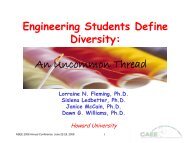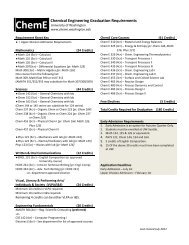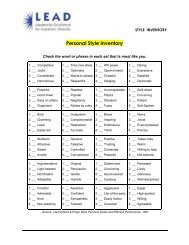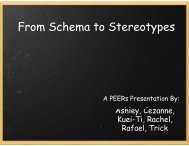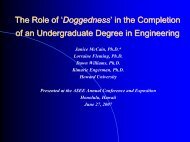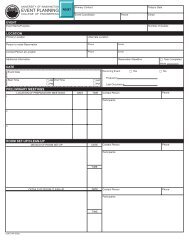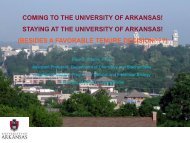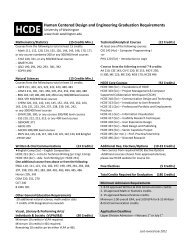Research Stars Light the Path - College of Engineering - University ...
Research Stars Light the Path - College of Engineering - University ...
Research Stars Light the Path - College of Engineering - University ...
- No tags were found...
Create successful ePaper yourself
Turn your PDF publications into a flip-book with our unique Google optimized e-Paper software.
Innovators<strong>Engineering</strong> Teams Break Down Communication BarriersCan you see me now? Sign language over cell phonesDeaf and hard-<strong>of</strong>-hearing Americans are a step closer to using sign language to communicateover a mobile phone. A UW team led by Eve Riskin, pr<strong>of</strong>essor <strong>of</strong> electrical engineering, hasdeveloped s<strong>of</strong>tware that enables two-way real-time video communication and has received aNational Science Foundation grant for a 20-person field project to begin next year. A video <strong>of</strong> <strong>the</strong> prototype postedon YouTube has drawn many emails. “A lot <strong>of</strong> people are excited about this,” Riskin said. Mobile video sign languagewon’t be widely available until a commercial cell-phone manufacturer agrees to provide <strong>the</strong> service.• For more information: http://mobileasl.cs.washington.edu/index.html. The video is posted at http://youtube.com/watch?v=FaE1PvJwI8E.Online service lets blind surf <strong>the</strong> Internet from any computer, anywhereRoughly 10 million people in <strong>the</strong> United States are blind or visually impaired. Use <strong>of</strong> a computerhas required special screen-reading s<strong>of</strong>tware typically installed only on <strong>the</strong>ir own machines. News<strong>of</strong>tware called WebAnywhere now lets blind and visually impaired people surf <strong>the</strong> Web on <strong>the</strong> go.The tool reads aloud Web text on any computer with speakers or headphone connections. JeffreyBigham, a Computer Science & <strong>Engineering</strong> doctoral student, developed WebAnywhere under <strong>the</strong> supervision <strong>of</strong>Pr<strong>of</strong>essor Richard Ladner. NSF funded <strong>the</strong> research. On July 8 in Paris, Bigham won <strong>the</strong> Accessible TechnologyAward for Interface Design at <strong>the</strong> Imagine Cup, a worldwide student programming contest sponsored by Micros<strong>of</strong>t.• The free program with audio and video demonstrations can be viewed at http://webanywhere.cs.washington.edu.For your eyes only: custom interfaces make clicking faster, easierOpen any computer program and you’re largely subject to a design team’s ideas about button sizes, fonts, and layouts.Off-<strong>the</strong>-shelf designs are especially frustrating for people with disabilities and <strong>the</strong> elderly. A new approach for designwould put each person through a brief skills test and <strong>the</strong>n generate a customized version <strong>of</strong> <strong>the</strong> user interface optimizedfor his or her vision and motor abilities. Computer Science & <strong>Engineering</strong> doctoral student Krzyszt<strong>of</strong> Gajosand Pr<strong>of</strong>essor Dan Weld designed <strong>the</strong> system, called Supple.The first applications will likely be Web-based.• For more information and a video demonstration: http://uwnews.org/article.asp?articleID=42817Toxic Chemicals (from page 9)“Nearly 100 volatile organic compounds wereemitted from <strong>the</strong>se six products. Plus, five <strong>of</strong> <strong>the</strong> sixemitted one or more carcinogenic ‘hazardous air pollutants,’which have no safe exposure level according to<strong>the</strong> Environmental Protection Agency,” Steinemann said.For instance, a plug-in air freshener contained morethan 20 different volatile organic compounds, sevenregulated as toxic or hazardous under federal laws.Environmental Impact Assessment Review publishedher study online in July. Steinemann has not disclosedproduct brand names. A subseqent study (submitted forpublication) analyzed 25 cleaners, personal care products,air fresheners, and laundry products and confirmed thatall brands <strong>of</strong> fragranced products contained similar toxicchemicals — even ones called “organic”and “natural.”In earlier work, two national surveys published bySteinemann and a colleague in 2004 and 2005 found thatabout 20 percent <strong>of</strong> respondents reported adverse heal<strong>the</strong>ffects from air fresheners and 10 percent reported sucheffects from laundry products vented to <strong>the</strong> outdoors.While <strong>the</strong> Food and Drug Administration requiresthat cosmetic packaging list ingredients, no law requires<strong>the</strong> manufacturers <strong>of</strong> consumer products to list all ingredientsor those in fragrances, even if toxic. “These chemicalsare a concern due to <strong>the</strong> potential for involuntaryexposure,” Steinemann said. “I’d like to see better labeling,and I hope this study will raise public awareness andhelp reduce exposures to potentially hazardous chemicals.”Her study has drawn media coverage in 13 countriesby more than 20 newspapers, 9 magazines, 35 radio andTV stations, and more than 100 websites — among <strong>the</strong>mCBS News, Scientific American, and <strong>the</strong> Hindustan Times.Quantum Dots (from page 8)times less toxic to <strong>the</strong> cell than <strong>the</strong> chemicals now used.Quantum dots are not yet approved for use inhumans so <strong>the</strong> researchers are transferring <strong>the</strong>ir techniquesto nontoxic iron oxide particles that havebeen approved by <strong>the</strong> Food and Drug Administration.“Eventually this method could be used to treat conditionsranging from cancer to deteriorating eyesight,”Gao said. “Our team also is working to target cancercells by attaching <strong>the</strong> quantum dots to specific markerson <strong>the</strong> cell’s surface.”• For more information, http://faculty.washington.edu/xgao/The research was funded by <strong>the</strong> National Institutes <strong>of</strong> Health and<strong>the</strong> National Science Foundation.10 TREND • Vol 58:2 • Autumn 2008



